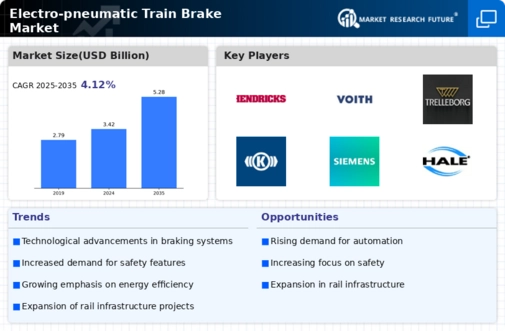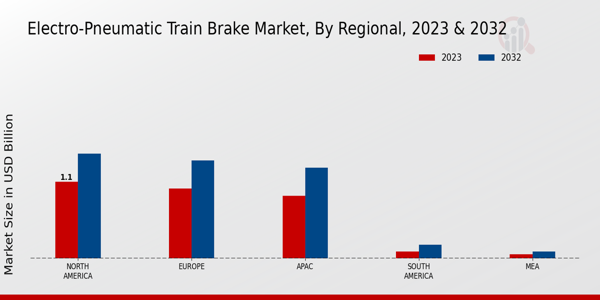Market Growth Projections
The Global Electro-pneumatic Train Brake Market Industry is poised for substantial growth, with projections indicating a market size of 3.42 USD Billion in 2024 and an anticipated increase to 5.28 USD Billion by 2035. This growth trajectory reflects a compound annual growth rate of 4.03% from 2025 to 2035, highlighting the increasing adoption of advanced braking technologies in rail systems. The market dynamics suggest a robust demand for electro-pneumatic brakes, driven by safety regulations, technological advancements, and the need for efficient rail transport solutions.
Regulatory Support for Modernization
Regulatory bodies worldwide are increasingly advocating for the modernization of rail systems, which significantly influences the Global Electro-pneumatic Train Brake Market Industry. Governments are implementing stringent safety regulations that necessitate the adoption of advanced braking technologies. This regulatory push not only enhances safety standards but also encourages investment in electro-pneumatic systems. As a result, the market is expected to grow steadily, with projections indicating a rise to 5.28 USD Billion by 2035. This growth underscores the importance of compliance with safety regulations and the modernization of rail infrastructure.
Technological Advancements in Brake Systems
Technological advancements play a pivotal role in shaping the Global Electro-pneumatic Train Brake Market Industry. Innovations such as real-time monitoring systems and predictive maintenance capabilities are enhancing the reliability and efficiency of braking systems. These advancements not only improve safety but also reduce operational costs for rail operators. The integration of smart technologies into electro-pneumatic brakes is likely to attract significant investment, further propelling market growth. As the industry evolves, the adoption of these technologies is expected to contribute to a compound annual growth rate of 4.03% from 2025 to 2035.
Growing Demand for Efficient Braking Systems
The Global Electro-pneumatic Train Brake Market Industry is witnessing a surge in demand for efficient braking systems, driven by the need for enhanced safety and operational efficiency in rail transport. As rail networks expand globally, the integration of electro-pneumatic brakes is becoming essential. These systems offer quicker response times and improved braking performance compared to traditional methods. For instance, the market is projected to reach 3.42 USD Billion in 2024, reflecting the industry's commitment to adopting advanced technologies that ensure passenger safety and reduce maintenance costs.
Focus on Sustainability and Environmental Concerns
Sustainability has become a central theme in the Global Electro-pneumatic Train Brake Market Industry, as stakeholders increasingly prioritize environmentally friendly technologies. Electro-pneumatic brakes contribute to reduced energy consumption and lower emissions compared to traditional braking systems. This focus on sustainability aligns with global efforts to combat climate change and promote greener transportation solutions. As rail operators seek to enhance their environmental credentials, the adoption of electro-pneumatic systems is expected to rise, further driving market growth in the coming years.
Increasing Urbanization and Rail Network Expansion
The trend of increasing urbanization is significantly impacting the Global Electro-pneumatic Train Brake Market Industry. As urban populations grow, the demand for efficient public transportation systems, including rail networks, rises. This expansion necessitates the implementation of advanced braking technologies to ensure safety and reliability in densely populated areas. Consequently, rail operators are investing in electro-pneumatic braking systems to meet these demands. The ongoing urban development projects worldwide are likely to further stimulate market growth, as cities seek to modernize their transport infrastructure.






















